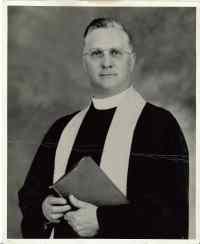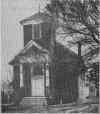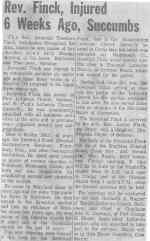The History of First Evangelical Lutheran Church of Odenton
 On the rainy afternoon of Sunday, September 8, 1940, the first Lutheran service in Odenton, Maryland, was held in the Junior Order Hall. The attendance was about 30 men, women and children. The preacher was the Reverend Emmanuel T. Finck, pastor of the Lutheran Church of the Resurrection in Baltimore. Of the residents of the Odenton area that were present, it seems only one, Mr. William Beckman, was a confirmed Lutheran. It was largely for this one man’s sake that Pastor Finck had begun this mission endeavor in Odenton.
On the rainy afternoon of Sunday, September 8, 1940, the first Lutheran service in Odenton, Maryland, was held in the Junior Order Hall. The attendance was about 30 men, women and children. The preacher was the Reverend Emmanuel T. Finck, pastor of the Lutheran Church of the Resurrection in Baltimore. Of the residents of the Odenton area that were present, it seems only one, Mr. William Beckman, was a confirmed Lutheran. It was largely for this one man’s sake that Pastor Finck had begun this mission endeavor in Odenton.
At the first
service those interested in starting a Lutheran Church in Odenton were requested to remain after the benediction for a meeting. The following Sunday, Pastor Finck returned for a second service. On September 22, a children’s choir sang for the first time, and immediately following the fifth service, on October 6, a Sunday School was organized. By the end of October 1940, this Sunday School boasted 2 teachers and 12 scholars.
In the first few years the following events occurred:
- December 22, 1940, the first children’s Christmas program took place and was attended by about 100 people.
- April 13, 1941, was the first Easter Sunrise service.
- July 20, 1941, was the first Communion service and 8 people were communed.
- Early in 1942, the Church was incorporated under the Laws of Maryland as First Evangelical Lutheran Church of Odenton.
- July of 1942, Southeastern District officially accepted First EvangelicalLutheranChurch as a member of the Evangelical Lutheran Synod of Missouri, Ohio and other States.
 All services from September 8, 1940 to September 20, 1942, were held at the Junior Order Hall at a rent of $5.00 a month. In 1942, a church building on 2nd & Watts Avenue was purchased at a cost of $800.00.
All services from September 8, 1940 to September 20, 1942, were held at the Junior Order Hall at a rent of $5.00 a month. In 1942, a church building on 2nd & Watts Avenue was purchased at a cost of $800.00.
1942 was memorable, also, for a number of first events in the church’s history; the first confirmation (the first class had one member – Ruth Horwath); the first 3-hour Good Friday Service; and the first Easter Egg Hunt. By the spring of 1943, First Lutheran had an active Young People’s Society. A men’s club and ladies auxiliary were already in existence. They had been founded in the first year. In 1943, the
congregation had about 70 communicant members.
The years from the end of the war, 1945 to 1955, were good years, marked by a continued growth and a wonderful spirit of Christian fellowship. Each year had its confirmation, special Easter services, strawberry festival, Sunday School Picnic and Christmas program.
 It was obvious by the mid 1950’s that the building was too small for the expanding congregation. On March 1, 1952, a building committee was formed and by 1955 the movement for a new building was in full swing. The lot at the junction of Routes 170 and 677 was purchased and plans for a new church building were selected. To help finance a construction program, the building committee launched a Bond drive. The Vestry approved the Bond campaign, February 1956, and in July the building committee was authorized to award Zedmack Corporation the contract for building a new church at the cost of $70,775.00.
It was obvious by the mid 1950’s that the building was too small for the expanding congregation. On March 1, 1952, a building committee was formed and by 1955 the movement for a new building was in full swing. The lot at the junction of Routes 170 and 677 was purchased and plans for a new church building were selected. To help finance a construction program, the building committee launched a Bond drive. The Vestry approved the Bond campaign, February 1956, and in July the building committee was authorized to award Zedmack Corporation the contract for building a new church at the cost of $70,775.00.
 The Ground Breaking Ceremony at the new lot occurred on May 20, 1956. The Corner Stone of the new building was laid on August 19th. The church was completed in the spring of 1957 and joyfully dedicated on April 7. At the dedication service, First Lutheran’s new dwelling was filled to overflowing. It was a long awaited day that will not soon be forgotten.
The Ground Breaking Ceremony at the new lot occurred on May 20, 1956. The Corner Stone of the new building was laid on August 19th. The church was completed in the spring of 1957 and joyfully dedicated on April 7. At the dedication service, First Lutheran’s new dwelling was filled to overflowing. It was a long awaited day that will not soon be forgotten.
The ladies auxiliary was instrumental in purchasing the equipment for the kitchen. They had a Snowball stand that helped with the cost of the purchase.
 In 1958, the congregation decided to establish a Christian Kindergarten. This new educational venture got under way on September 5th and was an immediate success. Mrs. Miriam Guyton was the first teacher. Her successor, Mrs. Rose Georg, began teaching in the fall of 1959 to be succeeded by Viia Erwin in September 1988.
In 1958, the congregation decided to establish a Christian Kindergarten. This new educational venture got under way on September 5th and was an immediate success. Mrs. Miriam Guyton was the first teacher. Her successor, Mrs. Rose Georg, began teaching in the fall of 1959 to be succeeded by Viia Erwin in September 1988.
 The members of First Lutheran were saddened by the news that on May 30, 1960, their beloved Pastor Finck was called to his eternal rest due to injuries he sustained in an automobile accident. The following Friday, his funeral service was held in the church he loved so dearly.
The members of First Lutheran were saddened by the news that on May 30, 1960, their beloved Pastor Finck was called to his eternal rest due to injuries he sustained in an automobile accident. The following Friday, his funeral service was held in the church he loved so dearly.
For the first time in its history, First Lutheran was without a Pastor. A Lutheran church in Gambrills faced the same problem. In 1947, Pastor Finck had founded St. Paul’s on Defense Highway in Gambrills and
had served as its spiritual shepherd until his death. Both congregations decided to call a Pastor jointly. Reverend Walter E. Koller was elected Pastor. He accepted the call and was installed on February 12, 1961. The church flourished under his guidance.
The need for a parsonage was satisfied by the purchase of the residence at 1307 Beverly Avenue, on November 3, 1961. The next month it was decided to sell the old church building on 2nd and Watts Avenue.
In the fall of 1962, Pastor Koller had to resign because of ill health. First Lutheran and St. Paul’s again decided to call a pastor jointly. At the December 27th call meeting the Reverend John L. Beck was elected pastor. He accepted the call and was installed in February 1963. He served both parishes until August 29, 1965, when Reverend James O’Connor was installed at St. Paul’s, Gambrills. For the first time, both parishes would be served by their own full-time minister.
The five years of Pastor Beck’s ministry is remembered for his emphasis on responsible lay leadership and adult Bible study within the congregation. In June 1968, he accepted a call to Grace Lutheran Church in Middleton, Connecticut.
First Lutheran was without a pastor for nearly nine months until the Reverend H. Douglas Rathjen accepted the call and was installed on March 2, 1969. Several important milestones in the history of First Lutheran occurred during the period of his ministry. In December of 1971, a new Constitution was adopted by the voters. One of the most significant changes of the new Constitution extended the voting privileges to women and lowered the age requirement to include 18 year olds. Prior to this time, although many women devoted much time and effort in the work of the church, they were not allowed to vote or hold a church office.
By 1971 the urgent need for a new organ had become apparent. Barbara Georg tendered her expertise in making a selection for a four rank pipe organ. It was purchased from the Wicks Organ Company, and was joyfully dedicated on March 5, 1972.
Following Pastor Rathjen’s resignation in 1973, the Reverend Daniel H. Quiram accepted our call and was installed as pastor on January 27, 1974. Under his leadership First Lutheran thrived. Two of Pastor Quiram’s most important contributions over his tenure were the revitalization of an active youth
ministry and the beginning of a successful evangelism outreach into the community.
 Renovation of the church’s undercroft was another step forward in the continued history of First Lutheran. Recognizing the necessity for more, adequate Christian facilities, the voters approved plans on May 12, 1975, for the construction of several classrooms and an office for the pastor. The building project progressed steadily through the summer, with members doing much of the work themselves. A special service and church picnic on August 24th marked the dedication of the new facilities. Reverend Quiram served until April 15, 1983, having accepted a call to Richmond, VA.
Renovation of the church’s undercroft was another step forward in the continued history of First Lutheran. Recognizing the necessity for more, adequate Christian facilities, the voters approved plans on May 12, 1975, for the construction of several classrooms and an office for the pastor. The building project progressed steadily through the summer, with members doing much of the work themselves. A special service and church picnic on August 24th marked the dedication of the new facilities. Reverend Quiram served until April 15, 1983, having accepted a call to Richmond, VA.
As the congregation grew the need for a fellowship building became apparent. In 1983 the Fellowship building was dedicated. It contained a new kitchen, Pastor’s office, Secretary’s office, Pre-Kindergarten area and a multi-purpose room.
Reverend Robert H. Bell served us from 1983 until April of 1990. During his time with us it was necessary to go to two Sunday morning services. During this time we had the opportunity to purchase the property at 1309 Beverly Avenue. This property was purchased for future expansion.
After serving as our interim pastor during our vacancy, Reverend Robert H. Hinz, graciously accepted our call in December of 1991. He served us faithfully until November 2001. Because of personal family obligations and health issues he decided to go into other aspects of ministry. It was during this time that the Mortgage on the church and all property was satisfied. First Lutheran became debt free. It was decided that the monthly sum that had been earmarked for the mortgage would be put in a Savings Account for future expansion.
Reverend Scott M. MacDonald was called and ordained in May of 2002. He has been instrumental in increasing the Adult Bible Study Program. Membership at First Lutheran has greatly increased during his tenure. He currently faithfully serves First Lutheran.
In approximately 2001, an Expansion Committee was formed to determine what renovations were needed to update the current Sanctuary and to make the Church better accessible to the physically challenged. A $100,000.00 challenge was made and went out to the congregation. It was met within one year. Our architect, John Corkhill, presented us with plans to fulfill our needs.
We believe that the expansion was in God’s plans for us because as instrumental people left, new responsible people stepped up to fill the void. This brings us to the fulfillment of the renovation plans and in December 2009 the Ground Breaking Ceremony occurred and ground was broken for the extension of our current church building. We believe that the new church will be a beacon for the community to see that God is in our midst and welcomes all.
From its humble beginnings to the present; God has richly blessed First Evangelical Lutheran Church of Odenton, The real significance of First Lutheran’s his
tory is that we have been the body of Christ in the community. Through good times and bad, God has provided strong lay leaders within the congregation to continue the ministry at First Lutheran. We have been a living witness to the ways in which God works in and through people. Pray that He will continue to bless us in the years ahead.
Other information can be obtained at http://www.odentonheritage.org/odenton-history/preservation/

